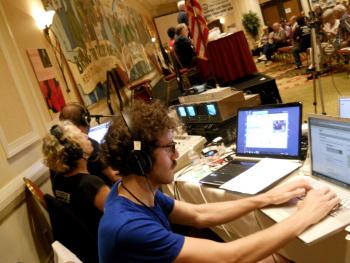Media Alliance

For residents of the town of Troy in upstate New York, the Sanctuary for Independent Media is the only place they can go to hear an anti-consumerist gospel choir, a lecture on race and media from a celebrated journalist, or a free jazz and electronica duet. But if the New York Media Alliance can get their low power station on the air, all of these events and more will be available to any of Troy's residents with a radio and an interest in community arts.
Founded in 1977, the Media Alliance is an advocacy group for media arts and artists, though its primary project is its community arts center, known as the Sanctuary. In this century-old church, the group has built audio and video production studios, as well as a performance space for visiting artists. While the board at the Media Alliance initially believed that their proximity to the state capitol Albany would allow them to spend most of their energy on media advocacy, they quickly found that they would first need to build a movement before they could start winning legislative victories.
“When we arrived, there was such a low level of awareness about community media and media arts that it made more sense to actually start doing it first and to try to develop a grassroots constituency and then increase advocacy once people have a better idea of what this is about,” said Media Alliance director Steve Pierce.
Along with their production studios and performances, the Sanctuary also promotes community media by holding film screenings, media workshops, and discussions led by artists and activists. With a low power radio station, Media Alliance plans to continue to offer this combination of music, education, and public affairs in its programming, allowing them to reach many residents who may have missed out on their events.
“Because this is one of the most economically disadvantaged neighborhoods in upstate New York, there's a large group of people here who aren't reached by conventional television or print media or email, so radio presents a different outreach strategy and would allow us to find people who are otherwise unreachable,” Pierce explained.
Although Pierce acknowledged that a radio station with a target audience of underserved listeners may struggle to find to financial support, he also noted that Media Alliance has thrived for over three decades by relying on meaningful contributions from hundreds of volunteers who appreciate the opportunity to uplift their community. With the power and reach of radio amplifying their efforts to build a movement through community arts, Pierce remained confident that getting on the air would be transformational in building their infrastructure for community organizing.
“Because low power radio is relatively cheap and offers great flexibility, we could run this station while continuing our other efforts as well,” Pierce said.
